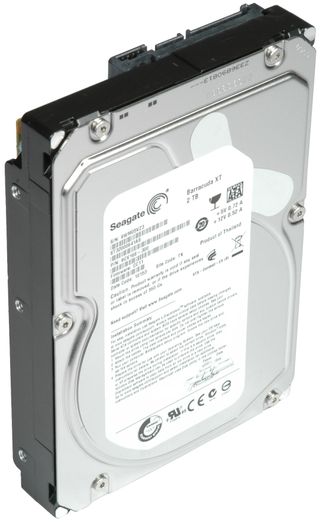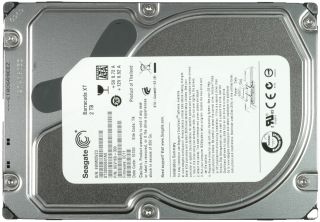Three New Desktop Hard Drives For 2010
Seagate Barracuda XT (ST32000641AS)

Seagate’s Barracuda XT is the first 6 Gb/s SATA hard drive we've received at our storage test lab. SAS drives with 6 Gb/s bandwidth reached the market first, but Seagate now claims the crown in the desktop space. Chris Angelini spent some time on this drive and Marvell’s new 6 Gb/s SSD controller in October 2009, when the drive delivered great results. Angelini ran it on a 3 Gb/s controller (part of Intel’s P55) versus the Marvell 88SE9128 and observed that it actually delivered slightly higher performance using the new, faster connect. We didn’t connect the drive to another controller for this article, preferring to keep our test platform consistent. In addition, most users will be running the Barracuda XT on 3 Gb/s controllers for a while. There are few disadvantage with the XT drive, as you can see in Angelini’s review.

The Barracuda XT was designed to be the best of the best in desktop storage, offering maximum capacity and maximum performance. The SATA 6 Gb/s interface is backed by 64MB of buffer memory. Only a few drives, such as WD’s Black Edition and RAID Edition, also come with 64MB, even though the cost for memory has come down. Apparently, cost pressure in the hard drive segment is stiff enough to inhibit larger caches. The Barracuda XT's rotation speed still is 7,200 RPM and, just like with Hitachi, there is only one Barracuda XT model (the 2TB) available in the family. However, Seagate stores these 2,000MB on only four (rather than five) platters. This helps keep the Barracuda XT's temperature lower. The measured 41°C is roughly 5°C less than on all the other 7,200 RPM 2TB hard drives.
Seagate's 139 MB/s maximum throughput isn’t fast enough to beat Samsung’s 1TB Spinpoint F3, and it can’t beat Western Digital’s Caviar Black 2TB or RE4 2TB drive. We measured average I/O performance numbers, knowing that the Barracuda XT was designed as a high-end desktop drive. Indeed, the XT delivers great performance in PCMark Vantage, proving that this is an excellent application drive. Only WD’s RE4 drive and, of course, the VelociRaptor are occasionally quicker.
The XT's 6.6W idle power isn’t revolutionary, but it's still good. The other 2TB drives are very close to this power consumption number. Seagate is much more power efficient at maximum streaming reads, where it doesn'tt exceed 8.5W. Other 2TB drives, including the previously-mentioned WD models, require more than 10W at peak performance. Similarly low-power consumption readings can be found during HD video playback and during high I/O activity using our workstation benchmark pattern. As a result, Seagate delivers impressive performance per watt, but it's still beaten by the 1TB Samsung Spinpoint F3 because that drive is much lower on power without lagging in performance.


Stay on the Cutting Edge
Join the experts who read Tom's Hardware for the inside track on enthusiast PC tech news — and have for over 25 years. We'll send breaking news and in-depth reviews of CPUs, GPUs, AI, maker hardware and more straight to your inbox.
Current page: Seagate Barracuda XT (ST32000641AS)
Prev Page Samsung Spinpoint F3 (HD103SJ) Next Page Comparison Table And Test SetupMost Popular

